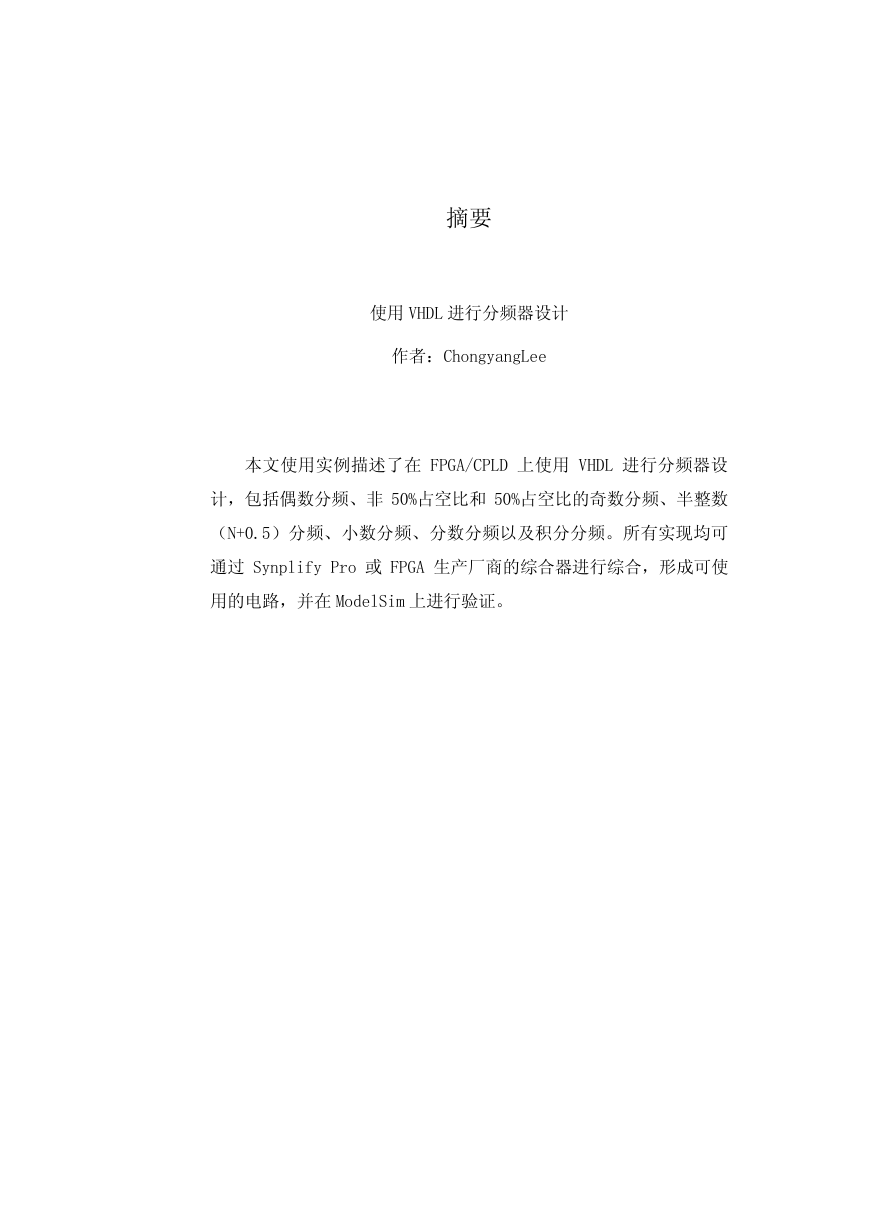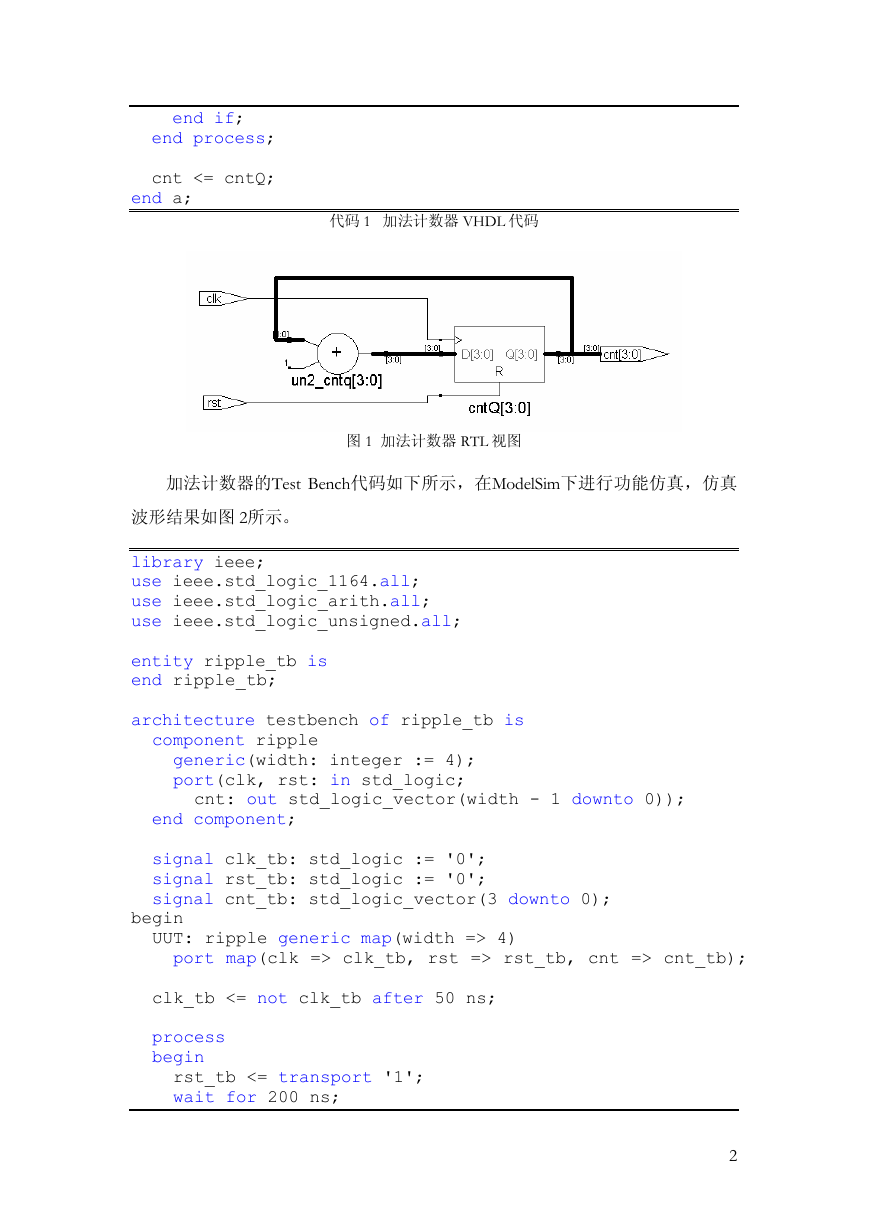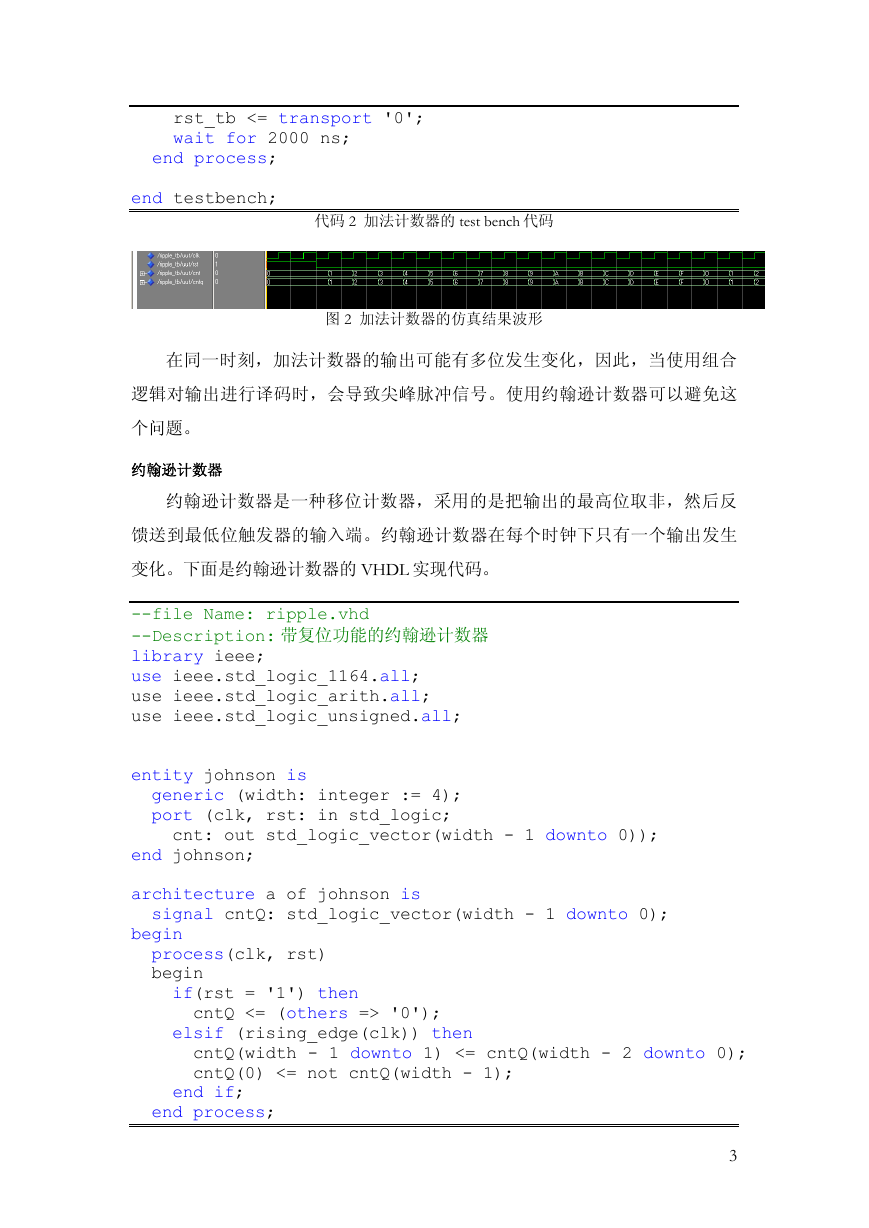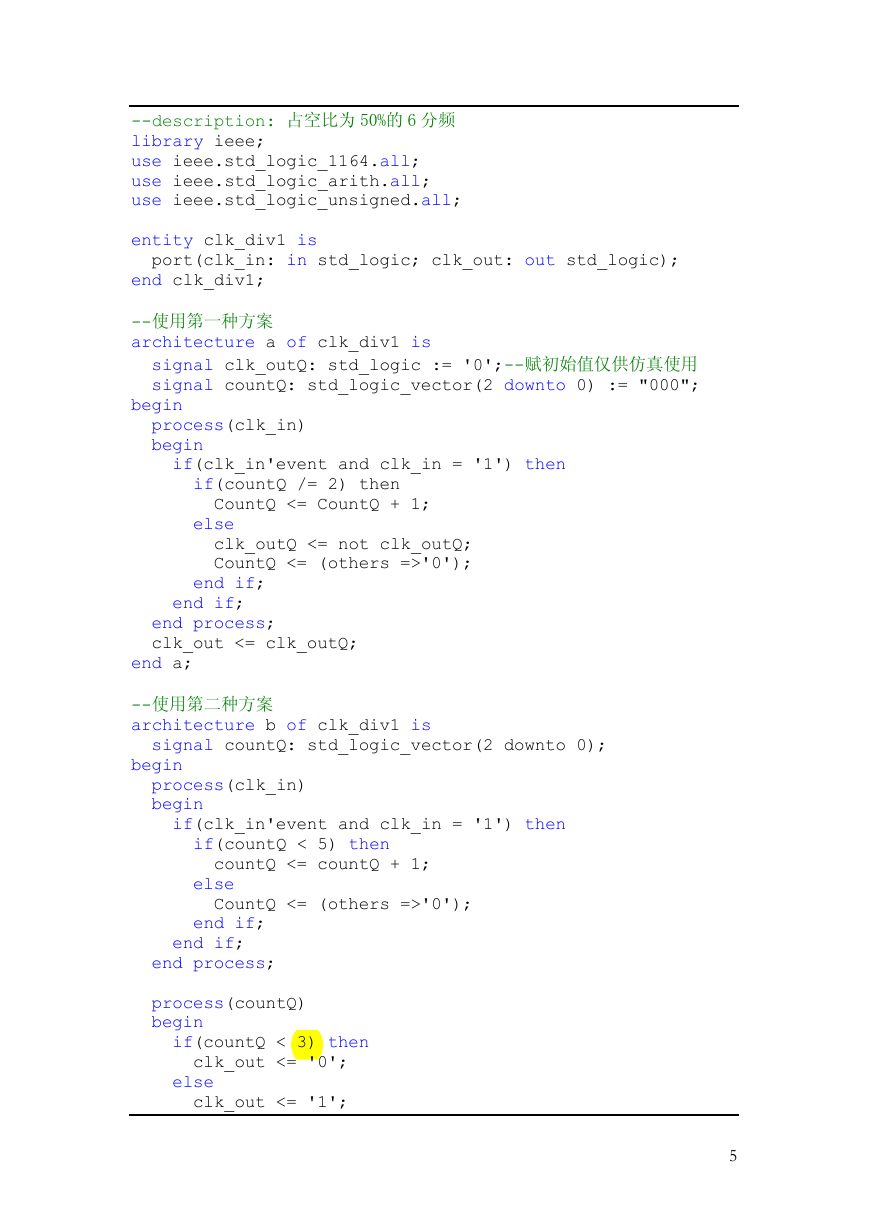使用 VHDL 进行分频器设计
作者:ChongyangLee
�
摘要
使用 VHDL 进行分频器设计
作者:ChongyangLee
本文使用实例描述了在 FPGA/CPLD 上使用 VHDL 进行分频器设
计,包括偶数分频、非 50%占空比和 50%占空比的奇数分频、半整数
(N+0.5)分频、小数分频、分数分频以及积分分频。所有实现均可
通过 Synplify Pro 或 FPGA 生产厂商的综合器进行综合,形成可使
用的电路,并在 ModelSim 上进行验证。
�
目录
概述.......................................................................................................................................1
计数器 ..................................................................................................................................1
普通计数器..................................................................................................................1
约翰逊计数器.............................................................................................................3
分频器 ..................................................................................................................................4
偶数分频器..................................................................................................................4
奇数分频器..................................................................................................................6
半整数分频器.............................................................................................................9
小数分频器................................................................................................................11
分数分频器................................................................................................................15
积分分频器................................................................................................................18
�
概述
分频器是数字电路中最常用的电路之一,在 FPGA 的设计中也是使用效率
非常高的基本设计。基于 FPGA 实现的分频电路一般有两种方法:一是使用
FPGA 芯片内部提供的锁相环电路,如 ALTERA 提供的 PLL(Phase Locked
Loop),Xilinx 提供的 DLL(Delay Locked Loop);二是使用硬件描述语言,如
VHDL、Verilog HDL 等。使用锁相环电路有许多优点,如可以实现倍频;相位
偏移;占空比可调等。但 FPGA 提供的锁相环个数极为有限,不能满足使用要
求。因此使用硬件描述语言实现分频电路经常使用在数字电路设计中,消耗不
多的逻辑单元就可以实现对时钟的操作,具有成本低、可编程等优点。
计数器
计数器是实现分频电路的基础,计数器有普通计数器和约翰逊计数器两
种。这两种计数器均可应用在分频电路中。
普通计数器
最普通的计数器是加法(或减法)计数器。下面是加法计数器的VHDL实
现,其Synplify Pro下的RTL View如图 1所示。
--file Name: ripple.vhd
--Description: 带复位功能的加法计数器
library ieee;
use ieee.std_logic_1164.all;
use ieee.std_logic_arith.all;
use ieee.std_logic_unsigned.all;
entity ripple is
generic (width: integer := 4);
port(clk, rst: in std_logic;
cnt: out std_logic_vector(width - 1 downto 0));
end ripple;
architecture a of ripple is
signal cntQ: std_logic_vector(width - 1 downto 0);
begin
process(clk, rst)
begin
if (rst = '1') then
cntQ <= (others => '0');
elsif (clk'event and clk = '1') then
cntQ <= cntQ + 1;
1
�
end if;
end process;
cnt <= cntQ;
end a;
代码 1 加法计数器 VHDL 代码
图 1 加法计数器 RTL 视图
加法计数器的Test Bench代码如下所示,在ModelSim下进行功能仿真,仿真
波形结果如图 2所示。
library ieee;
use ieee.std_logic_1164.all;
use ieee.std_logic_arith.all;
use ieee.std_logic_unsigned.all;
entity ripple_tb is
end ripple_tb;
architecture testbench of ripple_tb is
component ripple
generic(width: integer := 4);
port(clk, rst: in std_logic;
cnt: out std_logic_vector(width - 1 downto 0));
end component;
signal clk_tb: std_logic := '0';
signal rst_tb: std_logic := '0';
signal cnt_tb: std_logic_vector(3 downto 0);
begin
UUT: ripple generic map(width => 4)
port map(clk => clk_tb, rst => rst_tb, cnt => cnt_tb);
clk_tb <= not clk_tb after 50 ns;
process
begin
rst_tb <= transport '1';
wait for 200 ns;
2
�
rst_tb <= transport '0';
wait for 2000 ns;
end process;
end testbench;
代码 2 加法计数器的 test bench 代码
图 2 加法计数器的仿真结果波形
在同一时刻,加法计数器的输出可能有多位发生变化,因此,当使用组合
逻辑对输出进行译码时,会导致尖峰脉冲信号。使用约翰逊计数器可以避免这
个问题。
约翰逊计数器
约翰逊计数器是一种移位计数器,采用的是把输出的最高位取非,然后反
馈送到最低位触发器的输入端。约翰逊计数器在每个时钟下只有一个输出发生
变化。下面是约翰逊计数器的 VHDL 实现代码。
--file Name: ripple.vhd
--Description: 带复位功能的约翰逊计数器
library ieee;
use ieee.std_logic_1164.all;
use ieee.std_logic_arith.all;
use ieee.std_logic_unsigned.all;
entity johnson is
generic (width: integer := 4);
port (clk, rst: in std_logic;
cnt: out std_logic_vector(width - 1 downto 0));
end johnson;
architecture a of johnson is
signal cntQ: std_logic_vector(width - 1 downto 0);
begin
process(clk, rst)
begin
if(rst = '1') then
cntQ <= (others => '0');
elsif (rising_edge(clk)) then
cntQ(width - 1 downto 1) <= cntQ(width - 2 downto 0);
cntQ(0) <= not cntQ(width - 1);
end if;
end process;
3
�
cnt <= cntQ;
end a;
代码 3 约翰逊计数器 VHDL 代码
图 3 约翰逊计数器 RTL 视图
显然,约翰逊计数器没有有效利用寄存器的所有状态,假设最初值或复位
状态为
0000,则依次为 0000、0001、0011、0111、1111、1110、1100、1000、
0000 如 循环。再者,如果由于干扰噪声引入一个无效状态,如 0010,则无法
此
恢复到有效到循环中去,需要我们加入错误恢复处理,在此不再赘述。
分频器
如前所述,分频器的基础是计数器,设计分频
器的关键在于输出电平翻转
的时机。下面使用加法计数器分别描述各种分频器的实现。
偶数分频器
偶数分
频最易于实现,欲实现占空比为 50%的偶数 N 分频,一般来说有两
种方案:一是当计数器计数到
N/2-1 时,将输出电平进行一次翻转,同时给计
数器一个复位信号,如此循环下去;二是当计数器输出为 0 到 N/2-1 时,时钟输
出为 0 或 1,计数器输出为 N/2 到 N-1 时,时钟输出为 1 或 0
,当计数器计数到
N-1 时,复位计数器,如此循环下去。需要说明的是,第一种方案仅仅能实现占
空比为 50%的分频器,第二种方案可以有限度的调整占空比,参考非 50%占空
比的奇数分频实现。
在如下所示的以 6 分频为例的 VHDL 代码中, architecture a 使用的是第一种
方案,
architecture b 使用的是第二种方案。更改 configuration 可查看不同方案的
综合结果。
--filename clk_div1.vhd
4
�
;
t and clk_in = '1') then
;
ess(clk_in)
k_in'even
d_logic; clk_out: out std_logic);
--description: 占空比为 50%的 6 分频
library ieee;
use ieee.std_logic_1164.all;
use ieee.std_logic_arith.all;
use ieee.std_logic_unsigned.all
tity clk_div1 is
en
port(clk_in: in st
end clk_div1;
--
使用第一种方案
of clk_div1 is
architecture a
'0';--赋初始值仅供仿真使用
signal clk_outQ: std_logic :=
signal countQ: std_logic_vector(2 downto 0) := "000";
begin
proc
begin
if(cl
if(countQ /= 2) then
CountQ <= CountQ + 1
else
outQ <= not clk_outQ;
clk_
CountQ <= (others =>'0');
end if;
end if;
end process
;
clk_out <= clk
end a;
种方案
--
of clk_div1 is
architecture b
signal countQ: std_logic_vect
begin
proce
begin
if(c
if(countQ < 5) then
countQ <= countQ +
else
Coun
end if;
end if;
;
end process
begin
if(co
clk_out <= '0';
else
out <= '1';
clk_
process(countQ)
untQ < 3)
1;
tQ <= (others =>'0');
_outQ;
then
使用第二
or(2 downto 0);
ss(clk_in)
lk_in'event
and clk_in = '1') then
5
�
















 2023年江西萍乡中考道德与法治真题及答案.doc
2023年江西萍乡中考道德与法治真题及答案.doc 2012年重庆南川中考生物真题及答案.doc
2012年重庆南川中考生物真题及答案.doc 2013年江西师范大学地理学综合及文艺理论基础考研真题.doc
2013年江西师范大学地理学综合及文艺理论基础考研真题.doc 2020年四川甘孜小升初语文真题及答案I卷.doc
2020年四川甘孜小升初语文真题及答案I卷.doc 2020年注册岩土工程师专业基础考试真题及答案.doc
2020年注册岩土工程师专业基础考试真题及答案.doc 2023-2024学年福建省厦门市九年级上学期数学月考试题及答案.doc
2023-2024学年福建省厦门市九年级上学期数学月考试题及答案.doc 2021-2022学年辽宁省沈阳市大东区九年级上学期语文期末试题及答案.doc
2021-2022学年辽宁省沈阳市大东区九年级上学期语文期末试题及答案.doc 2022-2023学年北京东城区初三第一学期物理期末试卷及答案.doc
2022-2023学年北京东城区初三第一学期物理期末试卷及答案.doc 2018上半年江西教师资格初中地理学科知识与教学能力真题及答案.doc
2018上半年江西教师资格初中地理学科知识与教学能力真题及答案.doc 2012年河北国家公务员申论考试真题及答案-省级.doc
2012年河北国家公务员申论考试真题及答案-省级.doc 2020-2021学年江苏省扬州市江都区邵樊片九年级上学期数学第一次质量检测试题及答案.doc
2020-2021学年江苏省扬州市江都区邵樊片九年级上学期数学第一次质量检测试题及答案.doc 2022下半年黑龙江教师资格证中学综合素质真题及答案.doc
2022下半年黑龙江教师资格证中学综合素质真题及答案.doc